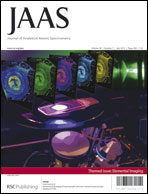Reassessment of relative oxide formation rates and molecular interferences on in situ lutetium–hafnium analysis with laser ablation MC-ICP-MS†
Abstract
A series of Hf and rare earth element (REE) solutions and glass beads have been produced in order to assess the influence of isobaric and molecular interferences on LA-MC-ICP-MS analysis of Lu–Hf isotopes in zircon. We demonstrate the capability to accurately correct for isobaric interferences of 176Yb on 176Hf at levels up to 176Yb/177Hf = 0.6 in solution mode. When using


 Please wait while we load your content...
Please wait while we load your content...